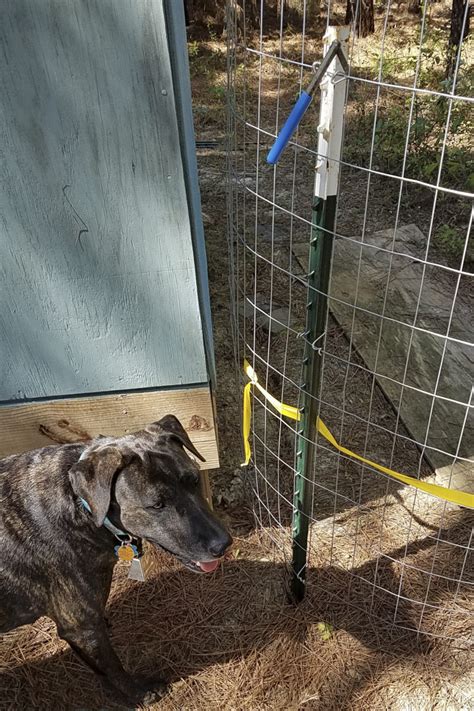Introduction
Keeping your canine companions safe and within your property boundaries is a paramount concern for all dog owners. Electric fencing, particularly hot wire fencing, has emerged as a popular solution due to its effectiveness, ease of installation, and relatively low cost. This article delves into the world of hot wire fencing for dogs, exploring its benefits, drawbacks, and practical applications.

Benefits of Hot Wire Fencing for Dogs
1. Enhanced Containment:
Hot wire fences deter dogs from escaping by delivering a mild, non-lethal shock when they touch or attempt to cross the electrified boundary. According to the American Veterinary Medical Association, over 10 million dogs are lost or stolen each year, highlighting the importance of secure containment.
2. Scalability and Flexibility:
Hot wire fencing can be customized to fit the shape and size of your property. It is easy to adjust or expand as your pet’s needs change or your property evolves.
3. Ease of Installation:
Compared to traditional fencing materials such as wood or chain-link, hot wire fencing is relatively simple and quick to install. This can save you time and money on professional installation costs.
Drawbacks of Hot Wire Fencing for Dogs
1. Potential for Injury:
While the shocks delivered by hot wire fences are intended to be non-lethal, they can still cause discomfort or pain if the dog receives multiple or extended shocks.
2. Animal Welfare Concerns:
Some animal welfare advocates express concerns that hot wire fencing can create a negative training environment and deter dogs from using certain areas of their yards.
Practical Applications
Hot wire fencing for dogs is suitable for a wide range of applications:
- Containment: Securing your dog within a specific area of your property.
- Barrier: Preventing access to potential hazards, such as roads, swimming pools, or garden beds.
- Training: Guiding dogs’ behavior, such as deterring them from jumping fences or digging holes.
How to Choose a Hot Wire Fencing System
1. Wire Material:
Aluminum and stainless steel are common materials for hot wires. Stainless steel is more durable but more expensive.
2. Voltage:
Fencing systems typically operate at 8,000-12,000 volts. Higher voltages result in stronger shocks.
3. Fence Height:
For small dogs, a fence height of 6-8 inches is sufficient. For larger dogs, 12-18 inches is recommended.
Installation Guidelines
- Mark the boundaries of the fenced area clearly.
- Install fence posts 10-15 feet apart.
- Stretch the hot wire tightly between the posts.
- Connect the wire to the fence charger and ground the system.
- Test the system thoroughly before allowing your dog near the fence.
Training Your Dog to Respect the Fence
- Introduce your dog to the fence gradually and under supervision.
- Allow the dog to feel a mild shock to establish the boundary and deter future crossings.
- Use positive reinforcement, such as treats or praise, when the dog respects the fence.
Alternatives to Hot Wire Fencing
- Invisible Fence: A system that uses buried wires and a receiver collar on the dog to deliver shocks when it crosses a boundary.
- Physical Barriers: Traditional fences, such as wood or chain-link, provide a physical barrier to prevent dogs from escaping.
- GPS Tracking Systems: These devices allow you to track your dog’s location and set virtual boundaries that trigger alerts when they are crossed.
FAQs
1. Are hot wire fences safe for dogs?
Yes, when properly installed and maintained, hot wire fences deliver non-lethal shocks that are designed to deter dogs from crossing the boundary.
2. Can hot wire fences cause long-term health problems?
No, hot wire fencing systems do not deliver shocks strong enough to cause long-term health problems. However, excessive or prolonged exposure to shocks can cause discomfort or anxiety.
3. How often should I test my hot wire fence?
Test your fence monthly or after any major storms or changes to the property.
4. What is the difference between an invisible fence and a hot wire fence?
Invisible fences use buried wires and a receiver collar to deliver shocks, while hot wire fences use electrified wires that are clearly visible above ground.
5. How much does it cost to install a hot wire fence?
The cost of installing a hot wire fence varies depending on the size of your property and the materials used. Typically, it ranges from $500 to $1,500 for materials and installation.
6. Can I install a hot wire fence without professional help?
While hot wire fencing is relatively simple to install, it is recommended to consult a professional electrician or fence installer for safety and optimal performance.
